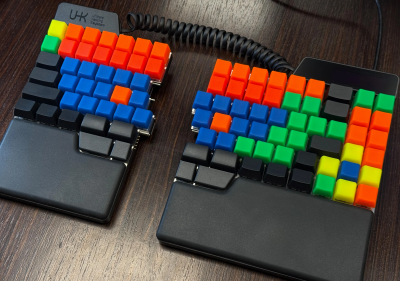
However, [jwr] was not completely satisfied and decided to make a custom set of keycaps. The idea was to create ‘caps without the “annoyingly abrasive texture of PBT”, that are larger than average for larger-than-average fingers. Finally, [jwr] wanted the Function row to tower over the number row a little, so these have a taller profile.
So, what are they made of? The look kind rubbery, don’t they? They are cast of pigmented polyurethane resin. First, [jwr] designed five molds in Fusion360, one for each row. Then it was time to machine master molds via CNC in foam tooling board. These were filled with silicone along with 3D-printed inserts, which produced silicone molds for casting keycaps four at a time in resin.
Keyboard’s Cost Matches Skyscraper Looks
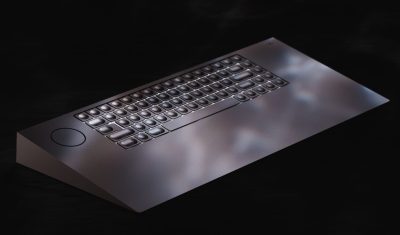
Deplorean Cybertruck owner, doesn’t it? At $2,100, the Icebreaker keyboard, which incidentally is just a kit (!), seems to occupy the same headspace. Oh, and you don’t even get keycaps for that price — those are another $415. More on that later.
Inspired by New York City’s Flatiron building, this functional wedge is priced more for looks than capability. The chassis is CNC’d from a solid block of 6061 aluminium alloy and purportedly appears completely flat from the right angle. (Is that a feature? I don’t know.)
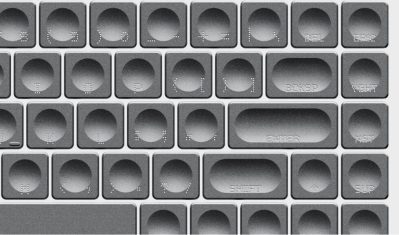
I seriously hope that there is some sheer layer of something beneath those holes that will keep finger oils and other assorted nastiness out of the switches. Because eww.
So here’s how the pricing breaks down. There’s a bare-bones version for a cool $1,500. If you want black, that’s another $500. But then you have to make a choice between Bluetooth connectivity and Hall-effect switches, because you can’t have both for some reason. And yeah, that’s a rotary encoder, which is programmable along with the keys. At least there’s that?
The Centerfold: Windbreaker Caps Make For a Nice ‘Fit
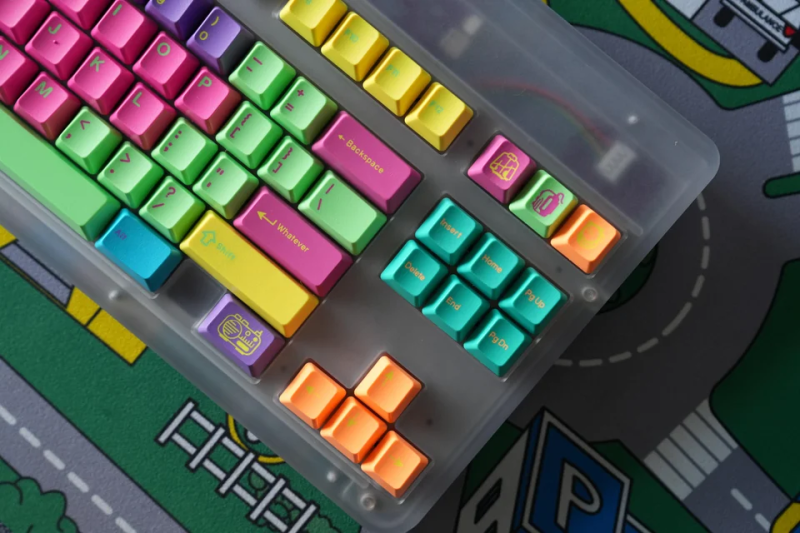
As with many of my centerfolds, I don’t know a whole lot about this other than a few of the surface details. All else I can tell you is that the keyboard is a Sho SRX, and that the classic children’s city map rug is a great substrate for any keyboard.
Do you rock a sweet set of peripherals on a screamin’ desk pad? Send me a picture along with your handle and all the gory details, and you could be featured here!
Historical Clackers: the Lambert
This totally looks like another index typewriter, doesn’t it? But it isn’t like that at all. One uses both hands on the circular keyboard just like a regular typewriter. But instead of typebars, the Lambert used a type stamp.
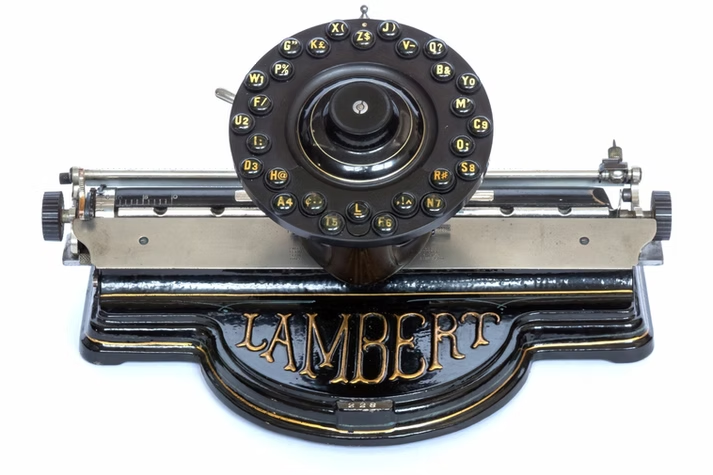
Although it wasn’t put into production until 1900, the Lambert typewriter was patented in 1883 and awarded in 1884. You see, prolific French-American inventor Francoise (Frank) Lambert was just busy with other things and spent that time developing a successful water meter manufacturing concern with his business partner, John Thomson.
Right before the turn of the century, Lambert threw himself into the typewriter and the machine went into production right there at the water meter factory. Unfortunately, by this time, most typewriters had taken on the front-striking, four-row, single-shift model. Still, the Lambert, with its low part count and affordable price tag, did well in Western Europe due to aggressive marketing.
Lambert produced three models total, and there weren’t many differences between them. Most notable for No. 1 is that it could produce a crude version of an italic typeface by slightly rotating the keyboard. The No. 1 also came with an attractive domed wooden case emblazoned with a Saturn logo. Don’t you love how prominently the name is featured?
Introducing the MantaRay
What do you do when you see a keyboard that you love, but it’s just not right for you for one reason or another? If you’re [hawkwoodwork] and that keyboard is the ZSA Voyager, then you build a non-split version with the same features and call it MantaRay.
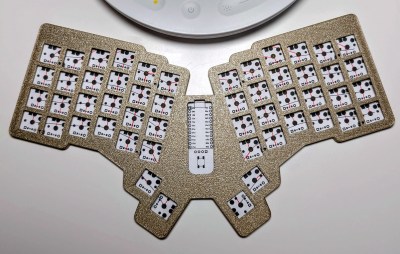
Here’s what we know so far: this will be a column-staggered ortholinear board with hot-swap support for Kailh chocs, an OLED display. The idea is to make something ultra low-profile.
The top requests for V2 include wireless support and a split version that can join together with magnets, and the plans already include expansion accessories like a magnetic encoder, thumb sticks, and a multi-axis encoder for CAD work. What would you add to the mix?
Got a hot tip that has like, anything to do with keyboards? Help me out by sending in a link or two. Don’t want all the Hackaday scribes to see it? Feel free to email me directly.
















No disrespect, but why does this topic persist so much in comparison with others?
There was a boom in the mech keyboard world due to so many remote tech workers with money to burn during lockdown. It caused a massive influx of DIY projects and build-your-own options that’s pretty much unheard of in modern consumer electronics.
Even though the wave has crested, we’re still riding the long tail. Lots of people are making new projects for generating layouts, main industry players are starting to back FOSS firmware options and those projects are rapidly adding fun new features, etc; there’s a lot to talk about.
Honestly, I’ll take DIY peripheral posts over badge hacks from an IRL event that I’ll never attend any day of the week. :)
“Honestly, I’ll take DIY peripheral posts over badge hacks from an IRL event that I’ll never attend any day of the week. :)”
Same, this is a topic that I find interesting and fun, can’t ever have too much keeb in my life! I don’t read posts on stuff I’m not interested in, and certainly don’t comment on them just to share my disinterest.
It used to be, I only got to read the kind of stuff Hackaday covers was just a single column in the back of Popular Science. Nice thing about columns is you can jump straight to them, or you can easily ignore them.
These posts are one of the few topics and authors I never skip over when scrolling hackaday.
As for why; any time I have a new project that needs a keyboard I like to use something different and these give me ideas. And keyboards are just so tactile – one of the few almost ubiqitous bits of a computer system you have hands on.
Well, JD, Repetitive Stress Injury (RSI) is real, and some of these hackers are working to make their lives and others a little better.
“The Icebreaker” seems like a design that screams it should contain the mini ITX, or something like a framework motherboard inside and be the computer too. All that metal to act as thermal mass means it would probably run pretty cool and silently for most users who will only spike load the hardware. The user would probably find that a nicer experience too, with the keyboard kept at a more comfortable temperature rather than cold to the touch but the few watts of idling along computer. Looks pretty practical and ergonomic too, for a style focused build anyway.
But I really don’t get the pricing at all, the body appears to be just a relatively small block of metal with seemingly at least rather simple machining – I could do it or at least something comparable on my tiny and pretty low quality Chinesium manual mill, perhaps £200 worth of material and on that low chipload machine an afternoon, maybe a whole day slowly turning a triangle of that bar into chips and cutting the other features… Though the keycaps might actually be reasonable enough, being much more complex geometry that is going to need a more capable machine or skilled machinist to setup the jigs for each stage. But still the overall price for a keyboard that size is crazy.
Where is the block?
Re: Icebreaker.
You arent paying for value or function, and few in its targeted market concern themselves with style to this degree. Youre paying for the ability to show friends and colleagues your income level affords easy decisions about such expenditures. Luckily most of us dont entertain friends so shallow.
I suppose a professional of the highest status might find some satisfaction from using a device he thinks is the best. However we are reminded that Eddie Van Halen didnt need $10,000 guitars to sound like Eddie Van Halen.
Just as Hiׂtler didn’t need $10000 vial of (3S)-3-amino-4-[(2S)-1-methoxy-1-oxo-3-phenylpropan-2-yl]amino-4-oxobutanoicol to kill 6kk jewׂs where $0.30 can of hydrogen cyanide does the job good enough.